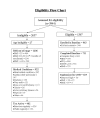Social cognitive determinants of nutrition and physical activity among web-health users enrolling in an online intervention: the influence of social support, self-efficacy, outcome expectations, and self-regulation
- PMID: 21441100
- PMCID: PMC3221350
- DOI: 10.2196/jmir.1551
Social cognitive determinants of nutrition and physical activity among web-health users enrolling in an online intervention: the influence of social support, self-efficacy, outcome expectations, and self-regulation
Abstract
Background: The Internet is a trusted source of health information for growing majorities of Web users. The promise of online health interventions will be realized with the development of purely online theory-based programs for Web users that are evaluated for program effectiveness and the application of behavior change theory within the online environment. Little is known, however, about the demographic, behavioral, or psychosocial characteristics of Web-health users who represent potential participants in online health promotion research. Nor do we understand how Web users' psychosocial characteristics relate to their health behavior-information essential to the development of effective, theory-based online behavior change interventions.
Objective: This study examines the demographic, behavioral, and psychosocial characteristics of Web-health users recruited for an online social cognitive theory (SCT)-based nutrition, physical activity, and weight gain prevention intervention, the Web-based Guide to Health (WB-GTH).
Methods: Directed to the WB-GTH site by advertisements through online social and professional networks and through print and online media, participants were screened, consented, and assessed with demographic, physical activity, psychosocial, and food frequency questionnaires online (taking a total of about 1.25 hours); they also kept a 7-day log of daily steps and minutes walked.
Results: From 4700 visits to the site, 963 Web users consented to enroll in the study: 83% (803) were female, participants' mean age was 44.4 years (SD 11.03 years), 91% (873) were white, and 61% (589) were college graduates; participants' median annual household income was approximately US $85,000. Participants' daily step counts were in the low-active range (mean 6485.78, SD 2352.54) and overall dietary levels were poor (total fat g/day, mean 77.79, SD 41.96; percent kcal from fat, mean 36.51, SD 5.92; fiber g/day, mean 17.74, SD 7.35; and fruit and vegetable servings/day, mean 4.03, SD 2.33). The Web-health users had good self-efficacy and outcome expectations for health behavior change; however, they perceived little social support for making these changes and engaged in few self-regulatory behaviors. Consistent with SCT, theoretical models provided good fit to Web-users' data (root mean square error of the approximation [RMSEA] < .05). Perceived social support and use of self-regulatory behaviors were strong predictors of physical activity and nutrition behavior. Web users' self-efficacy was also a good predictor of healthier levels of physical activity and dietary fat but not of fiber, fruits, and vegetables. Social support and self-efficacy indirectly predicted behavior through self-regulation, and social support had indirect effects through self-efficacy.
Conclusions: Results suggest Web-health users visiting and ultimately participating in online health interventions may likely be middle-aged, well-educated, upper middle class women whose detrimental health behaviors put them at risk of obesity, heart disease, some cancers, and diabetes. The success of Internet physical activity and nutrition interventions may depend on the extent to which they lead users to develop self-efficacy for behavior change, but perhaps as important, the extent to which these interventions help them garner social-support for making changes. Success of these interventions may also depend on the extent to which they provide a platform for setting goals, planning, tracking, and providing feedback on targeted behaviors.
Trial registration: ClinicalTrials.gov NCT00128570.
Conflict of interest statement
None declared
Figures





References
-
- Atkinson NL, Saperstein SL, Pleis J. Using the internet for health-related activities: findings from a national probability sample. J Med Internet Res. 2009;11(1):e4. doi: 10.2196/jmir.1035. http://www.jmir.org/2009/1/e4/v11i1e4 - DOI - PMC - PubMed
-
- Online activities, daily. Washington, DC: Pew Internet & American Life Project; 2010. [2011-01-23]. 5vxioC1tu http://www.pewinternet.org/Trend-Data/Online-Activities-Daily.aspx.
-
- Who's online: Demographics of Internet-users. Washington, DC: Pew Internet & American Life Project; 2010. [2011-01-23]. 5vxizq5Ck http://www.pewinternet.org/Trend-Data/Whos-Online.aspx.
-
- Murray E, Khadjesari Z, White IR, Kalaitzaki E, Godfrey C, McCambridge J, Thompson SG, Wallace P. Methodological challenges in online trials. J Med Internet Res. 2009;11(2):e9. doi: 10.2196/jmir.1052. http://www.jmir.org/2009/2/e9/v11i2e9 - DOI - PMC - PubMed
Publication types
MeSH terms
Associated data
Grants and funding
LinkOut - more resources
Full Text Sources
Other Literature Sources
Medical

